Laser Scanning Confocal Thermoreflectance Microscope for the Backside Thermal Imaging of Microelectronic Devices
Abstract
:1. Introduction
2. Experimental Methodology
2.1. Experimental Setup
2.2. Sample Description
2.3. Thermoreflectance Imaging Technique
2.4. System Configuration Characteristics
3. Results and Discussion
3.1. Image Acquisition
3.2. Confocal Thermoreflectance Measurement Characteristics: Resolution and Sensitivity
4. Conclusions
Acknowledgments
Author Contributions
Conflicts of Interest
References
- Farzaneh, M.; Maize, K.; Lüerßen, D.; Summers, J.A.; Mayer, P.M.; Raad, P.E.; Pipe, K.P.; Shakouri, A.; Ram, R.J.; Hudgings, J.A. CCD-based thermoreflectance microscopy: Principles and applications. J. Phys. D Appl. Phys. 2009, 42, 143001. [Google Scholar] [CrossRef]
- Mayer, P.M.; Lüerßen, D.; Ram, R.J.; Hudgings, J.A. Theoretical and experimental investigation of the thermal resolution and dynamic range of CCD-based thermoreflectance imaging. J. Opt. Soc. Am. A 2007, 24, 1156–1163. [Google Scholar] [CrossRef]
- Kim, D.U.; Park, K.S.; Jeong, C.B.; Kim, G.H.; Chang, K.S. Quantitative temperature measurement of multi-layered semiconductor devices using spectroscopic thermoreflectance microscopy. Opt. Express 2016, 24, 13906–13916. [Google Scholar] [CrossRef] [PubMed]
- Burzo, M.G.; Komarov, P.L.; Raad, P.E. Noncontact transient temperature mapping of active electronic devices using the thermoreflectance method. IEEE Trans. Compon. Pack. Tech. 2005, 28, 637–643. [Google Scholar] [CrossRef]
- Grauby, S.; Dilhaire, S.; Jorez, S.; Claeys, W. Imaging setup for temperature, topography, and surface displacement measurements of microelectronic devices. Rev. Sci. Instrum. 2003, 74, 645–647. [Google Scholar] [CrossRef]
- Singh, R.; Nurnus, J.; Bian, Z.; Christofferson, J.; Shakouri, A. Temperature profile inside microscale thermoelectric module acquired using near-infrared thermoreflectance. IEEE Trans. Compon. Pack. Tech. 2009, 32, 447–452. [Google Scholar] [CrossRef]
- Christofferson, J.; Shakouri, A. Thermal measurements of active semiconductor micro-structures acquired through the substrate using near IR thermoreflectance. Microelectron. J. 2004, 35, 791–796. [Google Scholar] [CrossRef]
- Tessier, G.; Bardoux, M.; Boué, C.; Filloy, C.; Fournier, D. Back side thermal imaging of integrated circuits at high spatial resolution. Appl. Phys. Lett. 2007, 90, 171112. [Google Scholar] [CrossRef]
- Tessier, G.; Bardoux, M.; Filloy, C.; Boué, C.; Fournier, D. High resolution thermal imaging inside integrated circuits. Sens. Rev. 2007, 27, 291–297. [Google Scholar] [CrossRef]
- Rampnoux, J.M.; Michel, H.; Salhi, M.A.; Grauby, S.; Claeys, W.; Dilhaire, S. Time gating imaging through thick silicon substrate: A new step towards backside characterization. Microelectron. Reliab. 2006, 46, 1520–1524. [Google Scholar] [CrossRef]
- Summers, J.A.; Yang, T.; Tuominen, M.T.; Hudgings, J.A. High contrast, depth-resolved thermoreflectance imaging using a Nipkow disk confocal microscope. Rev. Sci. Instrum. 2010, 81, 014902. [Google Scholar] [CrossRef] [PubMed]
- Pawley, J.B. Handbook of Biological Confocal Microscopy, 3rd ed.; Springer: Berlin/Heidelberg, Germany, 2006; pp. 207–220. ISBN 13: 987-0387-25921-5. [Google Scholar]
- Kubitscheck, U. Fluorescence Microscopy: From Principles to Biological Applications, 2nd ed.; Wiley-VCH: Weinheim, Germany, 2017; pp. 165–202. ISBN 978-3-527-33837-5. [Google Scholar]
- Grauby, S.; Salhi, A.; Rampnoux, J.-M.; Michel, H.; Claeys, W.; Dilhaire, S. Laser scanning thermoreflectance imaging system using galvanometric mirrors for temperature measurements of microelectronic devices. Rev. Sci. Instrum. 2007, 78, 074902. [Google Scholar] [CrossRef] [PubMed]
- Choi, W.J.; Ryu, S.Y.; Kim, J.K.; Kim, D.U.; Kim, G.H.; Chang, K.S. High-speed thermoreflectance microscopy using charge-coupled device-based Fourier-domain filtering. Opt. Lett. 2013, 38, 3581–3584. [Google Scholar] [CrossRef] [PubMed]
- Pedrotti, F.L.; Pedrotti, L.S. Introduction to Optics, 2nd ed.; Prentice-Hall: Upper Saddle River, NJ, USA, 1993; pp. 247–265. ISBN 0-13-016973-0. [Google Scholar]
- Ryu, S.Y.; Kim, D.U.; Kim, J.K.; Choi, H.Y.; Kim, G.H.; Chang, K.S. Surface-temperature measurement and submicron defect isolation for microelectronic devices using thermoreflectance microscopy. Int. J. Thermophys. 2015, 36, 1217–1225. [Google Scholar] [CrossRef]
- Tessier, G.; Polignano, M.L.; Pavageau, S.; Filloy, C.; Fournier, D.; Cerutti, F.; Mica, I. Thermoreflectance temperature imaging of integrated circuits: Calibration technique and quantitative comparison with integrated sensors and simulations. J. Phys. D Appl. Phys. 2006, 39, 4159–4166. [Google Scholar] [CrossRef]
- Ramsay, E.; Pleynet, N.; Xiao, D.; Warburton, R.J.; Reid, D.T. Two-photon optical-beam-induced current solid-immersion imaging of a silicon flip chip with a resolution of 325 nm. Opt. Lett. 2005, 30, 26–28. [Google Scholar] [CrossRef] [PubMed]

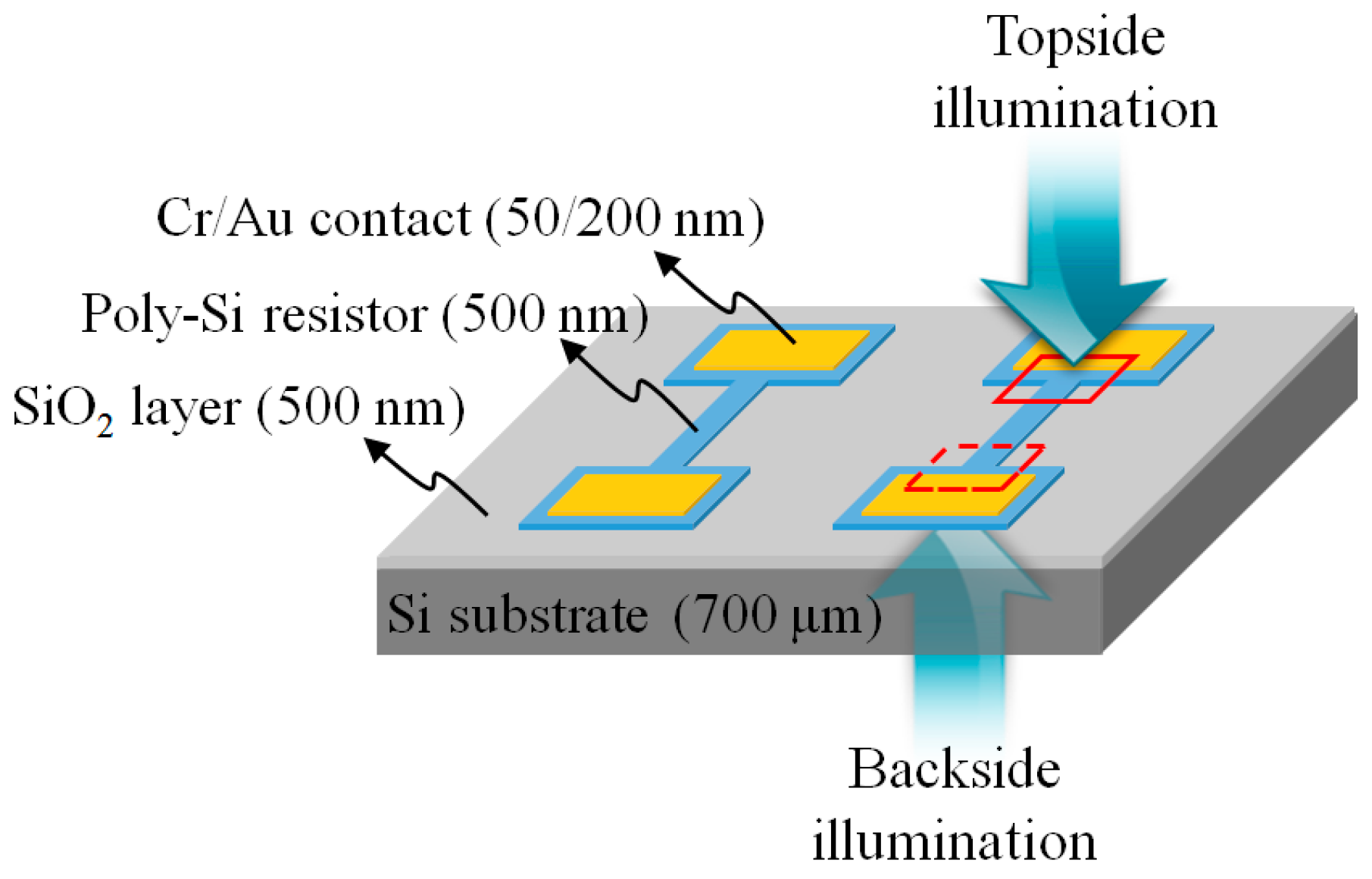

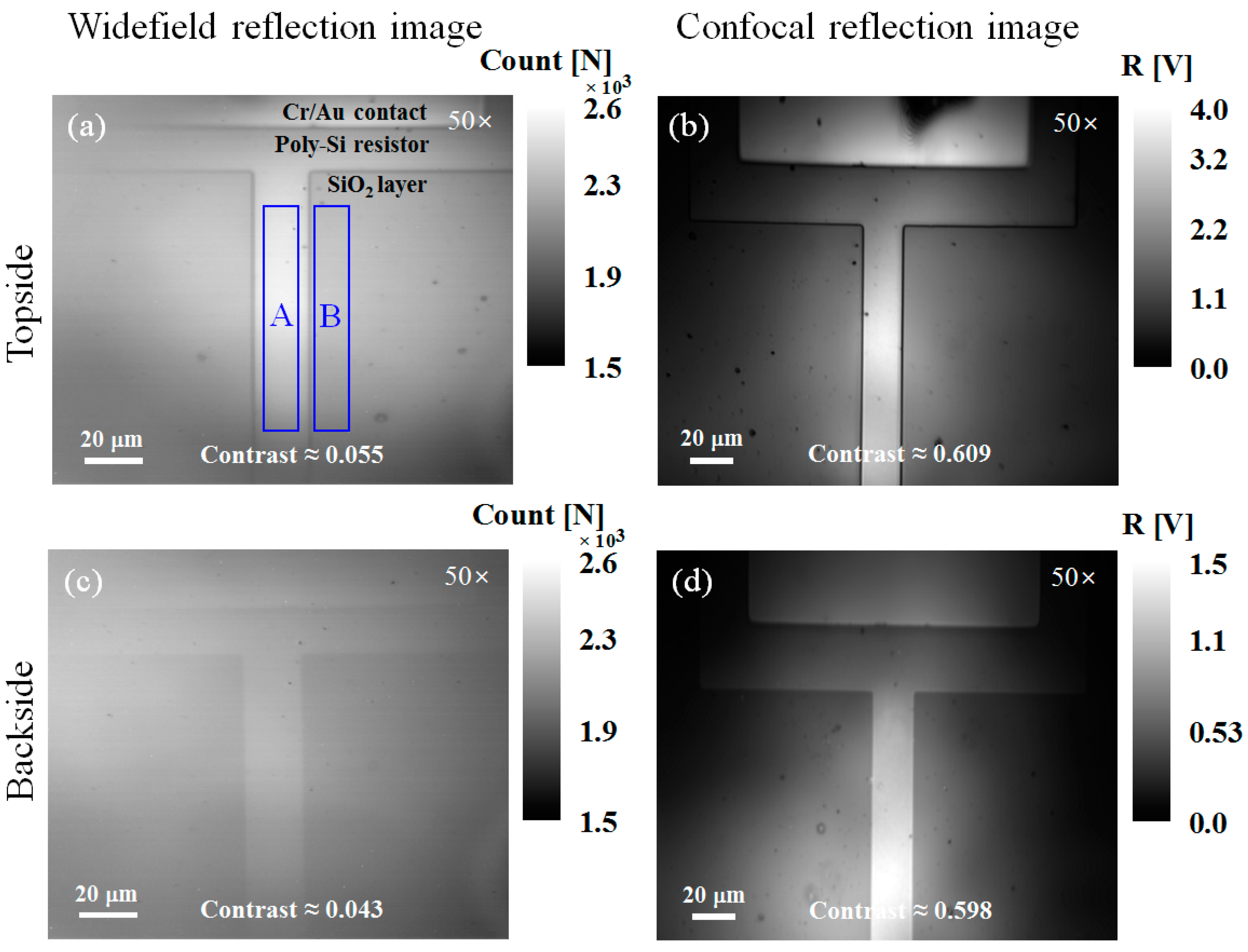
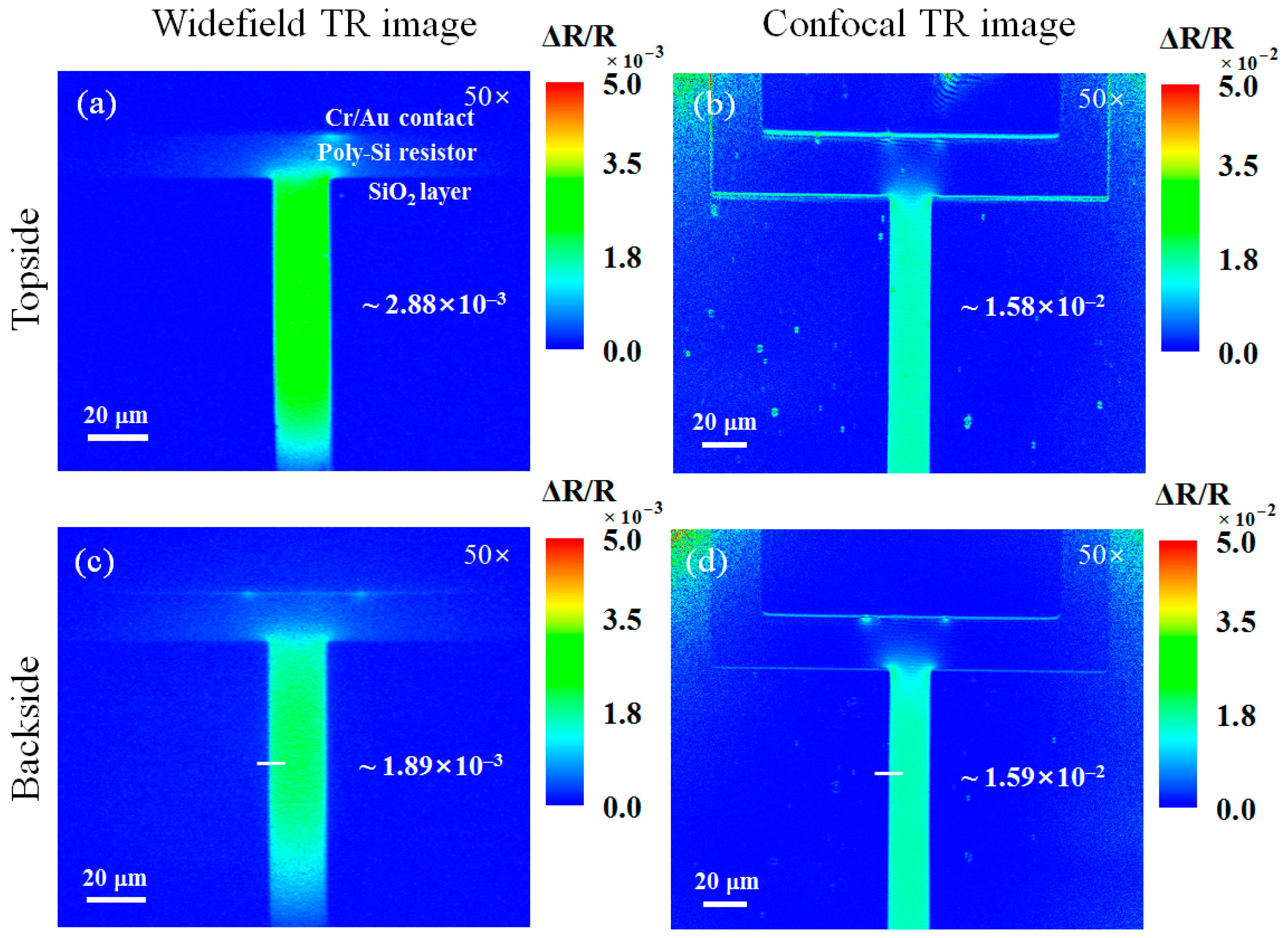
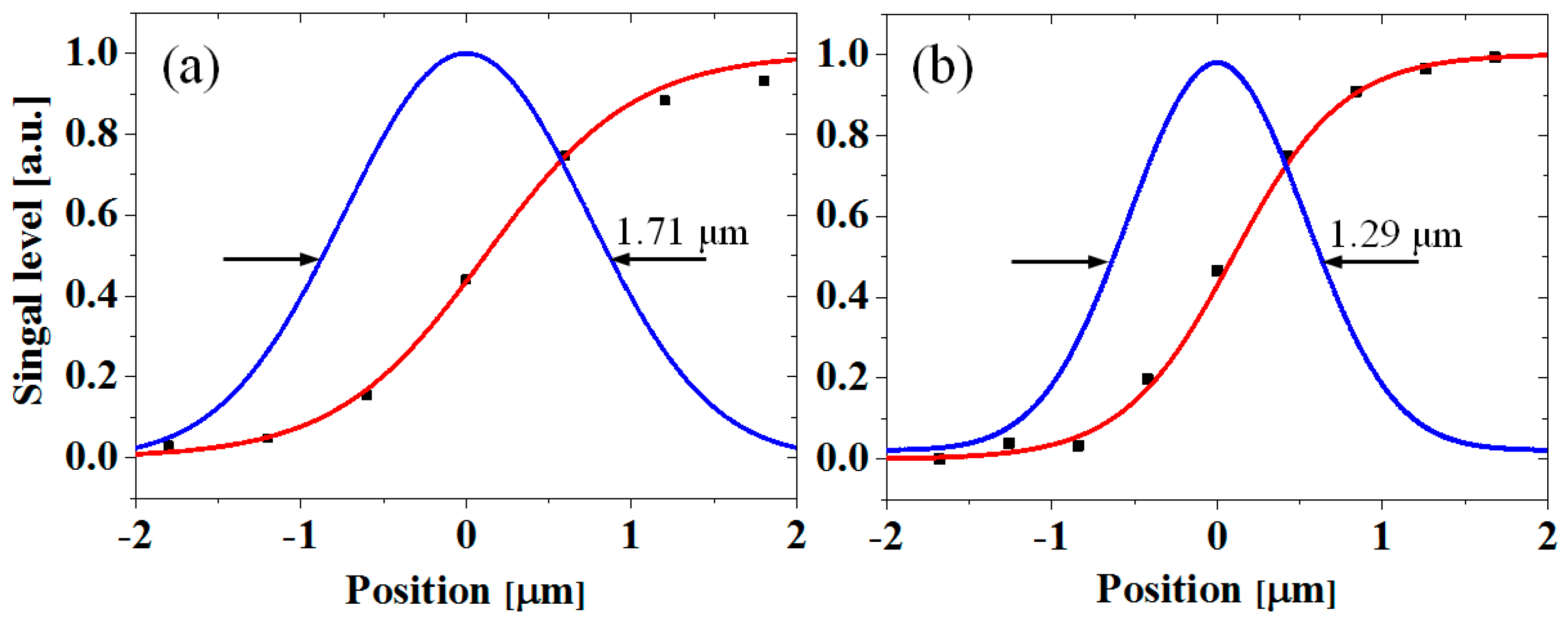

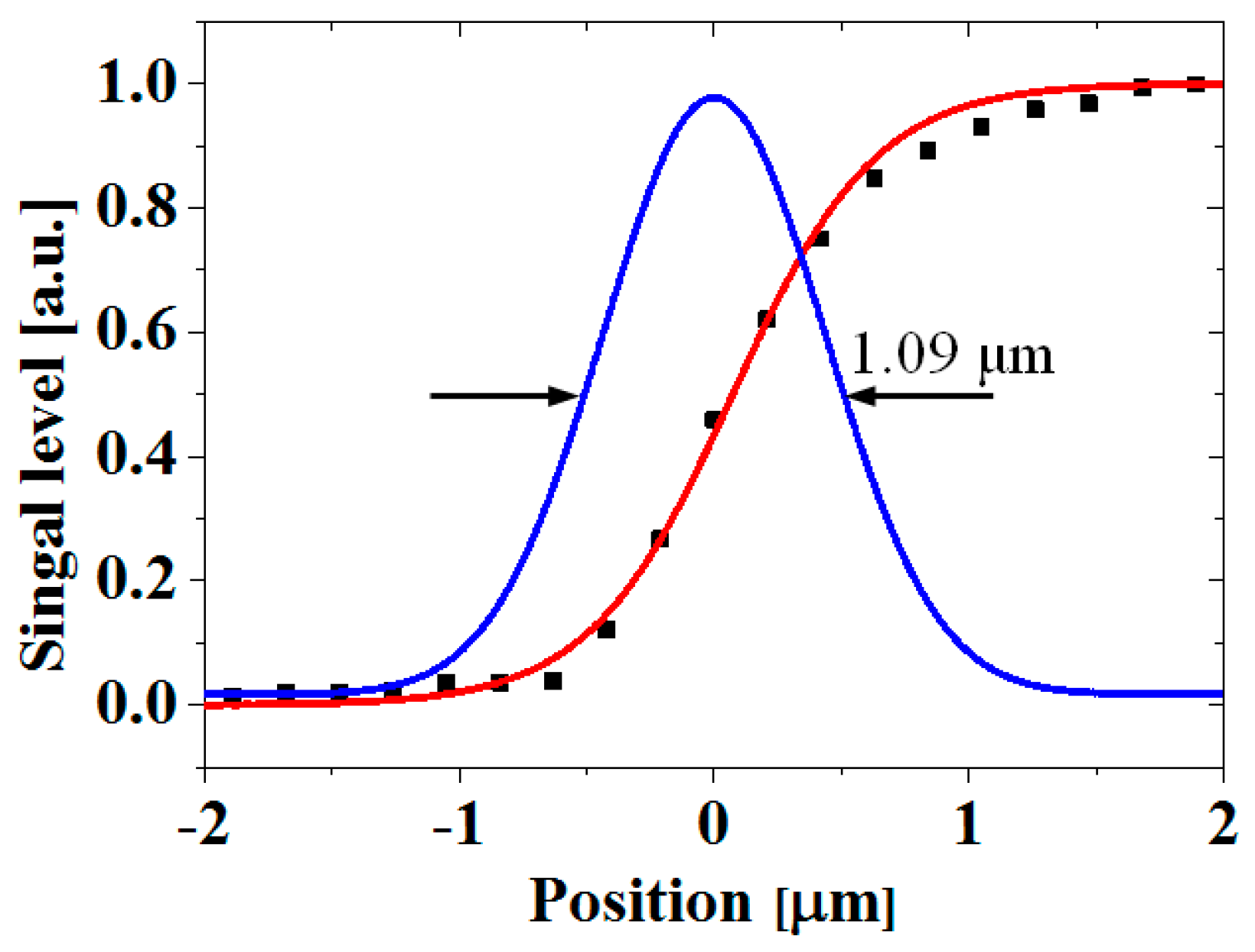
| Method of Topside Thermoreflectance Measurement | Illumination Wavelength (nm) | κ (K−1) | ΔT (K) |
|---|---|---|---|
| Widefield TRM using four-bucket method | 1150 ± 10 | −1.79 × 10−4 | 16.1 |
| Confocal TRM using Fourier-domain filtering method | 1150 | −1.04 × 10−3 | 15.2 |
© 2017 by the authors. Licensee MDPI, Basel, Switzerland. This article is an open access article distributed under the terms and conditions of the Creative Commons Attribution (CC BY) license (http://creativecommons.org/licenses/by/4.0/).
Share and Cite
Kim, D.U.; Jeong, C.B.; Kim, J.D.; Lee, K.-S.; Hur, H.; Nam, K.-H.; Kim, G.H.; Chang, K.S. Laser Scanning Confocal Thermoreflectance Microscope for the Backside Thermal Imaging of Microelectronic Devices. Sensors 2017, 17, 2774. https://doi.org/10.3390/s17122774
Kim DU, Jeong CB, Kim JD, Lee K-S, Hur H, Nam K-H, Kim GH, Chang KS. Laser Scanning Confocal Thermoreflectance Microscope for the Backside Thermal Imaging of Microelectronic Devices. Sensors. 2017; 17(12):2774. https://doi.org/10.3390/s17122774
Chicago/Turabian StyleKim, Dong Uk, Chan Bae Jeong, Jung Dae Kim, Kye-Sung Lee, Hwan Hur, Ki-Hwan Nam, Geon Hee Kim, and Ki Soo Chang. 2017. "Laser Scanning Confocal Thermoreflectance Microscope for the Backside Thermal Imaging of Microelectronic Devices" Sensors 17, no. 12: 2774. https://doi.org/10.3390/s17122774




